V. M. Padmapriya1,2
1,2Department of Electronics and Communication Engineering, School of Electrical and Electronics Engineering, SASTRA Deemed University, Thanjavur, Tamil Nadu, India.
DOI : https://dx.doi.org/10.13005/bpj/1531
Abstract
In recent trends, the image transmission over wireless communication system in 4G LTE (Long Term Evolution) grow into a challenging task. OFDMA (Orthogonal Frequency Division Multiple Access) plays a key role in data transmission (text, image and video) over wireless systems. In OFDMA several transformation techniques have been used for the transmission of images. But they have some drawbacks such as increased number of carriers, increased delay estimation, high ISI and ICI. Hence, to overcome these drawbacks, an image transmission over wireless communication is proposed using DWT technique. OFDMA has several benefits like less complexity, high flexibility and high spectral efficiency. However, still, it lacks in noise reduction and increased error rates. To avoid these issues, SC-FDMA (Single Carrier Frequency Division Multiple Access) techniques is introduced in this work for the image transmission over wireless communication systems. In this proposed work, a DWT based SC-FDMA system is implemented to reduce the noise and interference using wavelet transform analysis. The performance measure of SNR, PSNR, BER and MSE for the proposed DWT based SC-FDMA system is evaluated using MATLAB. The results indicate that the proposed technique affords superior performance with a reduced BER.
Keywords
Orthogonal Frequency Division Multiple Access; Single Carrier Frequency Division Multiple Access; Wavelet Transform; Wireless Communication; 4G LTE System
Download this article as:| Copy the following to cite this article: Padmapriya V. M. Image Transmission in 4G LTE Using DWT Based SC-FDMA System. Biomed Pharmacol J 2018;11(3). |
| Copy the following to cite this URL: Padmapriya V. M. Image Transmission in 4G LTE Using DWT Based SC-FDMA System. Biomed Pharmacol J 2018;11(3). Available from: http://biomedpharmajournal.org/?p=21632 |
Introduction
Wireless application has been developed more quickly than the wired amenities in recent times. The absolute need for wireless communication is its increased speed and high quality. With the intention of getting these demand, an authoritative multi-carrier modulation technique is required. Various modulation techniques have emerged in the ancient times. Among these, the OFDMA (Orthogonal Frequency Division Multiple Access) modulations techniques is the best model which has increased spectral efficiency over high data rate [1]. The architecture of OFDMA is explained as follows. Initially, the input signals are converted using a serial to parallel converter, and bit mapping is done. From this, the frequency domain signals are then converted into time domain signals using Inverse Fast Fourier Transform (IFFT). Then the signal is spread over a communication channel, and at the receiver side, the Fast Fourier Transform (FFT) can be utilized for converting the time domain signals into frequency domain signals. Then the signals are converted into bit streams using bit mapper, and finally, the signal is retrieved from the parallel to serial converter.
This OFDMA can eliminate the Inter-Symbol Interference (ISI) and noise in the channel. One among the main problems of OFDMA is the distortion in the transmitted signal while traveling through a channel. Because of the nonlinear effects in the high power amplifier, the OFDMA produces a High Peak-to-Average Power Ratio (PAPR) and Mean Square Error (MSE). These peaks of the multiple carriers are massively high which needs an increased power for the broadcast of data. On behalf of this purpose, OFDM is used for the downlink transmission in LTE which cannot be used for uplink transmission. This also becomes a drawback in the OFDMA system. Several existing techniques are used for the reducing the levels of interferences and noise in OFDMA. However, still, there may be a lack of the noise reduction and removal of unwanted signals from the system. Hence, a new technique called Single Carrier FDMA (SC-FDMA) technique is introduced recently to solve the issues mentioned above.
The broadcast of the image is a central provision in the third generation communication systems and also in the future generations [2]. The key resolution of this is to encounter the on system which can send the data at high speed with the acceptable level of bit error rate (BER). The wireless transmission medium is affected by the mobility of users and multipath propagation; the image transmission becomes a challenging demand in the mobile radio systems. Generally FFT is used for the transfer of images. However, it has some drawbacks like the increased number of carriers, increased delay estimation, high ISI and ICI. Hence, to overcome these issues, an image transmission over wireless communication is proposed in this work using the SC-FDMA-DWT technique. It is merely a developed form of the single carrier with frequency domain equalization (SCFDE) system which helps in the accommodating multiple access to multimedia services. It is implemented by the third generation partnership project (3GPP) for the uplink broadcast in the LTE system standardization. It consists of lower signal fluctuations which significantly absorbs less energy that results in the prolonged life period of the battery. This technique permits the system to reduce the signal distortions and PAPR problems. This SC-FDMA technique can be processed along with the DWT for the image transmission over wireless communication systems. The key goal of this paper is to remove the unwanted signals and noise during the image transmission using SC-FDMA. Also with the intention to improve the quality of image transmission by reducing the BER the DWT is used in this work. Also, it has the advantages such as.
Blocking artifacts are avoided as it has higher compression ratios.
The input need not be partitioned into non-overlapping blocks while coding.
It allows good localization both in time and spatial frequency domain.
It introduces inherent scaling and performs the transformation of the whole image.
Higher flexibility.
The remaining sections of this work are structured as follows: Section 2 examines some of the existing works related to image transmission techniques in wireless communication. Section 3 provides a comprehensive explanation of the proposed SC-FDMA system. Section 4 presents the performance results of the proposedsystem. Finally, this article is completed with the conclusion and future work in Section 5.
Related Work
The interference and noise are the most challenging issues in wireless transmission with high data rates. Due to the multipath propagation, ISI is caused which leads to an error and poor performance in the system. Also, it causes an increased sensitivity and High Peak-to-Average Power Ratio (PAPR). To overcome these issues, Ref. [3] introduced a technique of OFDMA-SC-FDMA systems with various modulation subcarrier mapping schemes. This proposed technique offers better results with good quality of image compared to the traditional techniques. In Ref. [4] a two-layer image encryption method for a Discrete Cosine Transform (DCT) pre-coded OFDM-VLC transmission is used. Here the two stages were involved in the transfer of images in which image encryption was implemented in the initial phase, and after that, the encrypted images were converted into digital signals. In this work, it improved the BER performance and also reduced the PAPR using DCT based pre-coding method. For secure image transmission without any noise or interference, Ref. [5]presented a technique for DFT pre-coded OFDM based VLC method with the use of Chebyshev chaos maps. In this work, the transmitted signals are encrypted using Chebyshev chaos and transformed using DFT method to acquire a secured image with improved BER performance.
The requirements for 4G LTE mobile communication systems are low BER, spectral efficiency, multiple channel bandwidths and high data rate. To encounter these requirements, Ref. [6] suggested OFDMA and SC-FDMA technique. It also enhanced the uplink transmission of data over the system. Associated with the conventional methods, the proposed method delivered better performances. Ref. [7] stated the difficulties in the communication of multimedia with various channel circumstances and bandwidth capabilities over a network. Some of the leading techniques in recent research areas like OFDMA techniques, Smart antennas and MIMO, cognitive radio, image compression and encryption methods were reviewed in this paper. Various modern signal processing techniques were also adopted for the analysis of these techniques. The features of OFDMA and CDMA were inherited to form a new multiple access technique called Multi-carrier Code Division Multiple Access (MC-CDMA) which was proposed in [8]. This proposed technique was used for image transmission over a range of networks. Also, the parameters used for analysing measures of image quality like SNR and BER were evaluated and compared with the existing methods. This proposed technique improved the performance of the system. The paper [9] studied the numerous techniques used for the image transmission over LTE communication system. The chief goal of this work was to find the efficient technique that enhanced the image transmission that was implemented over LTE system. Various modulation methods like QAM, BPSK and QPSK were also used in this work. By using these techniques, an optimum image transmission with better performance was obtained. In [10], the issues in the wireless communication of images over OFDM were investigated and evaluated for various modulation schemes, different channels and subcarrier mapping schemes. Initially, the OFDMA system model was implemented, and the metrics that are used for the evaluation of image quality like BER, MSE and PSNR were studied in this work. The results that were obtained from the proposed method improved the PSNR and MSE performances to a great extent.
For a very high data rate transmission over multipath access in 4G wireless services, OFDM was used [11]. In this article a MIMO OFDM wireless communication system with compression technique was implemented. Ref. [12] presented a method of reducing the peak to average power ratio in OFDM system. The method was based on DCT aided successive addition and subtraction of OFDM symbols inside the single OFDM frame. Using this technique in the receiver side, the transmitted symbols could be decoded easily by taking simply the differentiation after IDCT. Ref. [13] investigated MIMO-OFDM systems that function with deficient cyclic prefix (CP). The results show that, after only 2 iterations, the Bit Error Rate (BER) of the proposed equalization method can combine to that of a acceptable CP system alike when the channel delay spread is 6 times longer than the insufficient CP.
Ref. [14] analyzed numerous compression techniques and communication models. Various compression techniques such as Run Length Encoding (RLE), Precision Run Length Encoding (KRLE), Discrete Cosine Transform (DCT) and Wavelet Transform have been studied, where it was found that K-RLE reduce the data size more effectively than Run Length Encoding .Discrete Cosine Transform and Wavelet Transform had utilities in data compression as well as in noise elimination. Noise removal by median filter was more effective than average filters. This reduced the error rate by obtaining improving BER performances.
JPEG2000 based on channel allocation method and Orthogonal Frequency Division Multiplexing (OFDM) was proposed in[15]. This work was aimed to boost the quality of the secondary users received image by providing dynamic access to the unused spectrum, without violating the interference requirement to the primary user. Channels with better condition are used to transmit essential data in JPEG2000 coded bit-stream. Therefore, reception of determinative bits is guaranteed.
For a protected transmission of a colour image in an SCFDMA wireless communication system, an analysis of BER performances was studied in [16]. In this proposed work, an improved method of encryption technique based on the chaos image was implemented with three different channel equalization techniques and three different modulation schemes. The relative examinations of the proposed and existing technologies were carried out in this work. From the results of this work, it is detected that the QAM and ZF provide performance in the system. In Ref. [17] an efficient and robust source and channel coding algorithm were proposed for the improvement in the transmission of images over wireless communication systems. A modified OFDM was used for robust image transmission in which a Set Partitioning Hierarchical Trees (SPHIT) was used as a source coder and a Low-Density Parity Checker (LDPC) was used as a channel coder. This proposed method provided a reduction in PAPR for the OFDM signal. Also, significant improvements in PAPR and BER were obtained as a result of this method. In the recent generation of wireless systems, the image and video transmission at high data rates became applicable with the advancements in the data reliability. Here an imbalanced power allocation technique was introduced [18] over MIMO systems. This method was used to improve the transmission of images and videos in the MIMO communication systems by eliminating the noise and distortions in the signals. The technology that used multiple antennas for high performance 4G wireless system became popular in recent times. The range, reliability of communication systems and network capacity was increased. Here an OFDM method was used for high data rate transmission of images over the wireless network [19]. It could be combined with the multiple antennas to improve the system capacity and diversity gain in the MIMO-OFDM system. Also, a compressed technique called turbo coder was introduced in this work to improve the system coverage and reliability. Effective results were obtained in the BER performances of the image transmission system.
From the literature survey, it is concluded that even though the OFDM has various advantages like high spectral efficiency, low complexity, high flexibility and it is suitable for high data rate. However, this OFDM based wireless communication systems have some significant drawbacks like
Sensitive to time and frequency synchronisation errors
Reduced efficiency gains
High Peak to Average Power Ratio (PAPR)
Proposed Method
Several existing drawbacks that are analyzed from the survey are overcome by using a novel SC-FDMA technique for image transmission. In this section, the proposed SC-FDMA and their various sub-carrier mapping are discussed briefly. The functional block diagram of the proposed SC-FDMA technique is shown in Figure.1 and explained as follows.
From the diagram Figure. 1, it is observed that the block diagram of SC-FDMA is similar to that of OFDMA system. SC-FDMA has an additional section of DWT at the transmitter and IDWT at the receiver. Also the cyclic prefix is appended with the signal in transmitter side to reduce the bit losses during compression and it can be removed at the receiver side while retrieving the signals. In this projected SC-FDMA system, the input subcarriers are transmitted in serial which results in low PAPR than OFDMA system.
SC-FDMA
The transmission that is required for uplink communication is the primary consideration for LTE. SC-FDMA is a pre-coded OFDMA scheme which has a supplementary step of decoding after the process of conventional OFDM [20]. In general, SC-FDE (Single Carrier Frequency Domain Equalization) and FDMA (Frequency Division Multiple Access) systems are combined to form this SC-FDMA technique [1]. The highest powers of the sub-carriers are great in OFDMA which effects in the requirement of high power for the transmission of multiple subcarriers. The major consideration of PAPR can be enhanced by the replacement of OFDMA with a single carrier equivalent system. This is because the single carrier peaks require less power for transmission when compared to the multiple subcarriers. This can be attained by the use of spreading codes like DFT and IFFT with the same size. By using this spreading code, the multiple subcarriers has similar PAPR as that of single carrier which becomes SC-FDMA system due to their DFT and IDFT cancellation. Some processes are executed earlier to the transmission in SC-FDMA. No process of DFT can be done in the transmission of OFDMA whereas, in SC-FDMA, the operation of DFT is carried out before the transmission and hence it is also named as DFT-SC-FDMA.
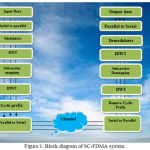 |
Figure 1: Block diagram of SC-FDMA system.
|
Sub-carrier Mapping
The sub-carriers are mapped using two methods such as the localised mapping method and distributed mapping method[3]. The localised mapping method is mentioned as a localised scheme in which the transmission of data for each user is carried out with consecutive subcarriers. Whereas the distributed mapping method is mentioned as a distributed scheme; The transmission of data for each user is carried out with distributed subcarriers. Among these, the distributed scheme is more powerful in contrast to the frequency selective fading because of the information signals that are distributed across the whole signal band.
Wavelet Transform Analysis
The Discrete Wavelet Transform (DWT) is applied to the input image which has established a substantial reputation in image compression and shown in Figure 2. This wavelet coding scheme is appropriate for scalability and degradation of tolerability in the packages. Recently, a new coding called JPEG-2000 has been released based on DWT. It is a frequency domain image method which is used to fragment the signal into sub-signals. The prime objective of this DWT method is to conceal the data in the form of coefficients, and it can be analyzed in the filter banks. This wavelet is represented using the dilations and transferring for a signal which can be expressed as [21]
![]()
Where a is the scaling parameter
b is the shifting parameter
t is the discrete value in random variable x (t).
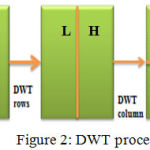 |
Figure 2: DWT process.
|
The Algorithm of DWT
The steps that involved in DWT process are as follows:
DWT is applied to the structure of an image of size A x B pixels providing four sub-images: LL, LH, HL, and HH with the size of
![]()
These sub-images cause four coefficient vectors with each of length
![]()
These coefficient vectors are evenly quantized and are binary coded with M bits or coefficient to arrange four-bit
The bit streams are then collected in the form of packets and are plotted on the SC-FDMA system.
The parameters that are used in this work are input image, number of subcarriers, IFFT size, modulation method, the ratio of energy and signal to noise in dB. The input image must be selected with 8-bit grayscale bitmap file (*.bmp), and the IFFT size must be minimum of 8. The digital modulation methods used in this work are QPSK, 8-PSK, 16-QAM and 64-QAM.
Modulation and Demodulation
The SC-FDMA is a technique in which the frequency spacing of carriers are a pair of 1/T where T is the period required for modulation. It is considered by an overlap of spectral signal that is transmitted on various carriers. In the modulation method, each modulator has an allocated pattern that is identical, and the polar coordinates of the transmitted signal comparative to kth carrier in the interval [(j-1)T,jT], the signal that is communicated can be signified as
![]()
Where,
![]()
is the elemental frequency
The signal transmitted on the channel is a total of sinusoidal carriers, modulated with arbitrary phase and amplitude.
![]()
is the signal transmitted on the channel

where N is the number of sinusoidal carriers.
The time duration of SC-FDMA modulation impulse can be expressed as
![]()
Where D is the source bit-rate
A is the bit quantity of each transmitted symbol
Ts is the time period of a symbol
The demodulation process of SCFDMAdepends upon the subcarrier’s orthogonality. It is collected by a set of demodulators with a matched filter that are used for both the in-phase and in-quadrature components. The demodulation process considers two necessary conditions like carrier synchronisation and clock synchronisation.
Experimental results and discussions
This section evaluates the performance of the image transmission over wireless communication systems using SC-FDMA technique. The performance of this proposed technique is analysed using the parameters like SNR, PSNR and MSE in the transmitted signal.
Signal-to-Noise Ratio
Signal to noise ratio is the comparison of the preferred signal level with the noise level. i.e., it is calculated as the proportion of power of signal and noise which are denoted in decibels (dB).
![]()
In decibels, SNR will be expressed as
![]()
Mean Square Error
The Mean Square Error can be defined as the measure of the typical square of the errors. For image transmission it can be stated as

Where, M2 is the number of pixels
lo and lr are the transmitted and received images respectively.
Peak Signal-to-Noise Ratio
The Peak Signal-to-Noise Ratio can be obtained from the proportion of maximum powers in the signal to the noise. Usually, PSNR can be conveyed through logarithmic decibel (dB).
![]()
Where,
![]()
is the maximum pixel value of the image. It helps in the analysis of quality of the received image.
In this work, the performance measures are analyzed for the input images with various size and modulation methods are considered for the analysis of SNR and BER in the image transmission.
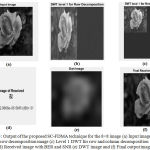 |
Figure 3: Output of the proposed SC-FDMA technique for the 8×8 image (a) Input image (b) Level 1 DWT row decomposition image (c) Level 1 DWT for row and column decomposition image (d) Received image with BER and SNR (e) DWT image and (f) Final output image.
|
Table 1: Performance analysis for 8×8 pixel image
| Parameters | Values |
| SNR | 31 |
| PSNR | 20.2370 |
| MSE | 615.7126 |
| BER | 2.9866e-06 |
Table 1. shows the performance measures of the proposed SC-FDMA technique for 8×8 pixel input image.
The parameters like SNR, PSNR and MSE for the proposed SC-FDMA technique are 31, 20.2370 and 615.7126 respectively. The results of the proposed SC-FDMA technique for 8×8 input image is shown in Figure 3. The SNR value can be obtained as 31 with BER of 2.9866e-06.
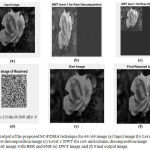 |
Figure 4: Output of the proposed SC-FDMA technique for 64×64 image (a) Input image (b) Level 1 DWT row decomposition image (c) Level 1 DWT for row and column decomposition image (d) Received image with BER and SNR (e) DWT image and (f) Final output image.
|
Table 2: Performance analysis of 64×64 pixel image
| Parameters | Values |
| SNR | 31 |
| PSNR | 27.7831 |
| MSE | 108.3363 |
| BER | 3.0149e-06 |
Table 2 shows the performance measures of the proposed SC-FDMA technique for 64×64 pixel input image. The parameters like SNR, PSNR and MSE for the proposed SC-FDMA technique are 31, 27.7831 and 108.3363 respectively and Output of the proposed SC-FDMA technique for the 64×64 image is shown in Figure 4.
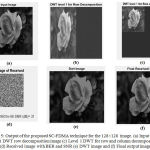 |
Figure 5: Output of the proposed SC-FDMA technique for the 128×128 image. (a) Input image (b) Level 1 DWT row decomposition image (c) Level 1 DWT for row and column decomposition image (d) Received image with BER and SNR (e) DWT image and (f) Final output image.
|
Table 3 shows the performance measures of the proposed SC-FDMA technique for 128×128 pixel input image. The parameters like SNR, PSNR and MSE for the proposed SC-FDMA technique are 31, 29.8944and 66.6261respectively and Output of the proposed SC-FDMA technique for the 128×128image is shown in Figure 5.
Table 3: Performance analysis for 128×128 pixel image
| Parameters | Values |
| SNR | 31 |
| PSNR | 29.8944 |
| MSE | 66.6261 |
| BER | 2.9931e-06 |
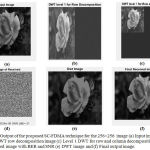 |
Figure 6: Output of the proposed SC-FDMA technique for the 256×256 image (a) Input image (b) Level 1 DWT row decomposition image (c) Level 1 DWT for row and column decomposition image (d) Received image with BER and SNR (e) DWT image and (f) Final output image.
|
From this evaluation, it is observed that even though in the substantial pixel variation of the 256×256 image is shown in Figure 6. The rate of PSNR reached maximum level with reduced error rate using our proposed SC-FDMA technique.
Table 4: Performance analysis for 256×256 pixel image
| Parameters | Values |
| SNR | 31 |
| PSNR | 30.0955 |
| MSE | 63.6100 |
| BER | 3.0024e-06 |
Table 4. shows the performance measures of the proposed SC-FDMA technique for 256×256 pixel input image. The parameters like SNR, PSNR and MSE for the proposed SC-FDMA technique are 31, 30.0955 and 63.6100 respectively.
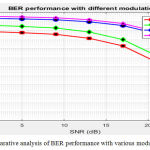 |
Figure 7: Comparative analysis of BER performance with various modulation techniques.
|
The overall comparison of the BER performances for various modulation techniques like QPSK, 8-PSK, 16-QAM and 64-QAM methods are analysed with AWGN channel. The comparative examination of these modulation methods is shown in Figure 7. From the graph, it is observed that the QPSK modulation has a minimum BER error at various SNR rates. Also the BER that are obtained using this proposed technique provides better performance compared to the existing OFDM technique[21].The QPSK performance of the proposed SCFDMA shows better results compared to the existing OFDMA technique
Conclusion and Future work
In this work, the issues of image transmission in wireless communication systems over OFDMA are discussed. Even though OFDM have various advantages, still it lacks in some criteria like increased bit error rate, high PAPR and reduced efficiency. To avoid these drawbacks, an SC-FDMA technique is implemented in this work for the transmission of image over wireless communication systems. In this proposed work, the SC-FDMA is implemented to check and reduce the error using wavelet transform analysis. The performances like SNR, PSNR, BER and MSE are evaluated using MATLAB. The results indicate that the proposed technique offers better performance with a reduced error. Also, the BER for different modulation techniques is evaluated and concluded that the proposed SC-FDMA technique with QPSK modulation provides reduced BER. In future, the security of the SC-FDMA technique will be improved by using suitable encryption algorithm.
Acknowledgements
The authors wish to acknowledge SASTRA Deemed University, Thanjavur, India for extending infrastructural support to carry out this work.
References
- M. F. Pervej, M. Z. I. Sarkar, T. K. Roy, M. M. Hasan, M. M. Rahman, and S. K. Bain, (2014) Analysis of PAPR Reduction of DFT-SCFDMA System using Different Sub-carrier Mapping Schemes, pp. 435–439.
CrossRef - A. B. Sediq and M. El-Tarhuni, (2006) Improved image transmission over wireless channels IEEE GCC Conf. GCC.
- F. S. Al-Kamali, A. A. Qasem, S. A. Abuasbaa, and G. A. Qasem, (2016) SC-FDMA and OFDMA: An Efficient Wireless Image Transmission Schemes,J. Control Syst. Eng., vol. 4, no. 1, pp. 74–83.
CrossRef - Z. Wang, F. Chen, W. Qiu, S. Chen, and D. Ren, (2018) A two layer chaotic encryption scheme of secure image transmission for DCT precoded OFDM-VLC transmission, Opt. Commun., vol. 410, no. September 2017, pp. 94–101.
- Z. Wang and W. Qiu, (2017) Secure Image Transmission over DFT-precoded OFDM-VLC systems based on Chebyshev Chaos scrambling, Opt. Commun., vol. 397, no. February, pp. 84–90.
CrossRef - S. Tripathi and R. Paulus, (2017) Design and Analysis of OFDMA and SC-FDMA for LTE Uplink Enhancement,vol. 10, no. 8, pp. 2675–2684.
- S. E. El-Khamy, (2017)Recent research trends in wireless multimedia communications, 2017 34th Natl. Radio Sci. Conf., no. Nrsc, pp. 1–1.
- R. Craciunescu, C. Voicu, A. Vulpe, and S. Halunga, (2014) Performance analysis of MC-CDMA system when image transmission is involved,” in Communications (COMM), 2014 10th International Conference on, pp. 1-4.
- S. A. Bhat and A. Singh, (2017) Review on Effective Image Communication Models,” Australian journal of Basic science and science, 11(8).
- A. A. Qasem, Wireless Images Transmission over OFDMA Systems : Investigation and Evaluation,” IEEE GCC Conf. GCC .pp. 1–25.
- R. Meena and H. Mirja, (2017)MIMO-OFDM Systems for the Development of 4G Wireless Networks by using Hermitian Encoding, vol. 7, no. 7, pp. 14021–14025.
- H. Sakran, M. Shokair, and a A. Elazm, (2014) PAPR Reduction in Ofdm Systems,IEEE India conference, INDICON vol. 6, pp. 67–78,. vol. 6, pp. 67–78.
- T. Pham, T. Le-Ngoc, G. Woodward, P. A. Martin, and K. T. Phan, (2016)Equalization for MIMO-OFDM systems with insufficient cyclic prefix,IEEE Veh. Technol. Conf., vol. 2016–July, pp. 8–12.
- M. Chandral, D. Agrwal, and A. Bansae, (2016) Image transmission through wireless channel: A review IEEE Int. Conf. Power Electron. Intell. Control Energy Syst., pp. 1–4.
- G. Javadi, A. Hajshir mohammadi, and J. Liang, (2015) JPEG2000 image transmission over OFDM-based Cognitive Radio network, in Computing and Communication (IEMCON), International Conference and Workshop on, 2015, pp. 1-6.
- J. J. Sadique and S. E. Ullah, (2013) Performance Analysis of SC-FDMA Wireless Communication System with Implementation of Chaos-Based Image Encryption Scheme, International Journal of Future Generation Communication and Networking, vol. 6, pp. 85-94.
- S. Akhila and N. Shivanand,(2014)PAPR Reduction using OFDM Technique with Rate and Power Allocation Employed with JSCC Coding Technique, IJCA proceedings on information and communication technologies ICICT, vol. 5, pp. 17-22.
- P. B. Kowale and P. B. Kurhade, (2014) Enhancing Image and Video Transmission by Applying Unequal Power Allocation , over MIMO OFDM System,” International journal of computer and mobile computing,vol. 3, no. 5, pp. 439–443.
- P. Dahiya, I. Ggsipu, K. Gate, and N. Delhi, (2013)Turbo coded MIMO-OFDM systems,International journal of Engineering and innovative technology, vol. 3, no. 3, pp. 312–316.
- Q. Zheng, Y. Chen, H. Lee, R. Dreslinski, C. Chakrabarti, A. Anastasopoulos, S. Mahlke, and T. Mudge, (2014)Using Graphics Processing Units in an LTE Base Station, J. Signal Process. Syst., vol. 78, no. 1, pp. 35–47.
CrossRef - S. M. Patil and P. V. P. Kaduskar,( 2017 )Image & Video Transmission through OFDM Channel and Noise Estimation and Removal for Wavelet Transform Analysis, vol. 50, no. 2, pp. 67–74.







